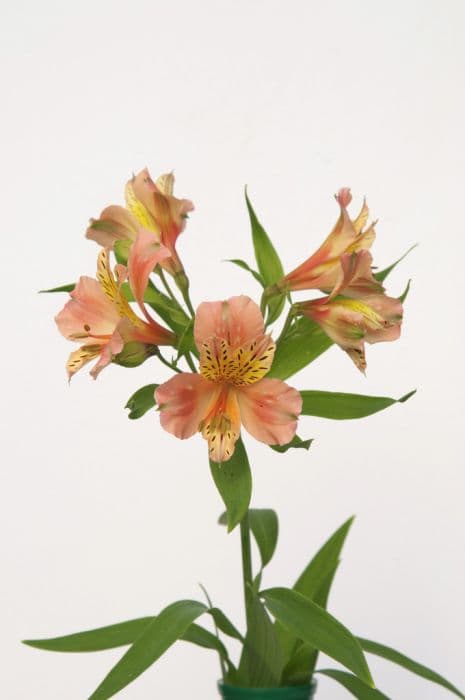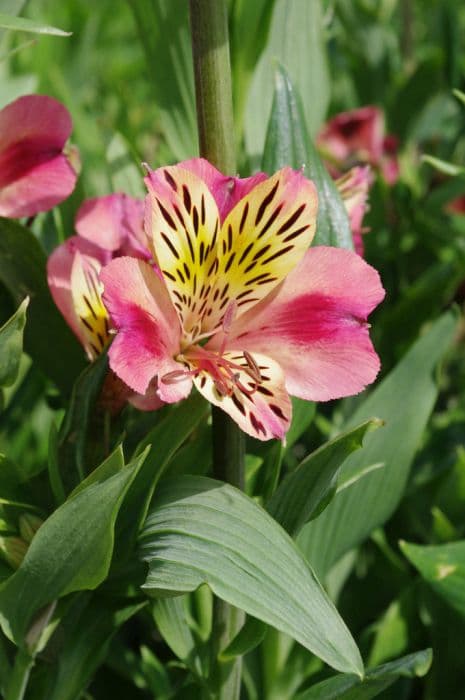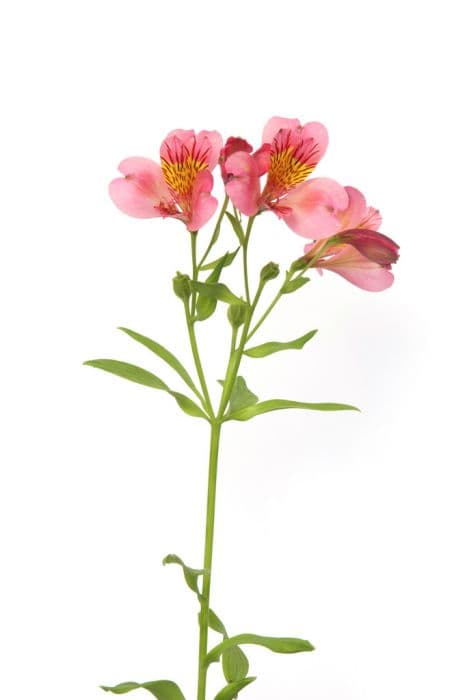Peruvian lily Alstroemeria 'Golden Delight'

ABOUT
Alstroemeria 'Golden Delight', commonly known as Peruvian Lily, is an eye-catching flowering plant known for its vibrant colors and intricate patterns. This cultivar boasts blossoms with brilliant golden-yellow petals, often adorned with streaks or flecks of deep brown or maroon, adding to their exotic look. The petals are typically curved, giving the flowers a lily-like appearance that is full of texture and depth. The Peruvian Lily's flowers cluster at the top of slender, upright stems, surrounded by lance-shaped leaves that point in different directions, providing a lush green backdrop that makes the golden blooms even more striking. Each flower has six petals, with the inner three being slightly narrower and often more intensely colored near the base, enhancing the dynamic display. 'Golden Delight' exudes a aura of warm vibrancy, and the striking contrast between the golden yellow blooms and the dark markings creates a dazzling effect in any garden setting. The plant's splendid blossoms are also long-lasting, whether displayed in the garden or as cut flowers in arrangements, making it a popular choice for festive bouquets and floral displays.
About this plant
 Names
NamesFamily
Alstroemeriaceae
Synonyms
Peruvian Lily, Lily of the Incas, Parrot Lily, Peruvian Lily 'Golden Delight'
Common names
Alstroemeria 'Golden Delight'.
 Toxicity
ToxicityTo humans
The Peruvian Lily, while beautiful, can have negative effects on humans if ingested. Though not considered highly poisonous, eating parts of the plant may cause mild gastrointestinal symptoms, such as nausea, vomiting, or diarrhea. In some individuals, handling the plant might result in skin irritation or dermatitis due to the presence of tuliposides - compounds that can cause allergic reactions. It is advisable to exercise caution and avoid eating any part of the Peruvian Lily.
To pets
The Peruvian Lily is also known to be mildly toxic to pets. If a pet, such as a cat or dog, ingests parts of the plant, they may exhibit symptoms like vomiting, diarrhea, or drooling. In some cases, they might also display signs of lethargy. While the plant is not typically life-threatening, it can cause discomfort and distress for the animal. To ensure the safety of your pets, it's best to keep them away from the Peruvian Lily and to seek veterinary care if you suspect they have ingested any part of it.
 Characteristics
CharacteristicsLife cycle
Perennials
Foliage type
Deciduous
Color of leaves
Green
Flower color
Yellow
Height
2-3 feet (60-90 cm)
Spread
1-2 feet (30-60 cm)
Plant type
Bulb
Hardiness zones
7
Native area
South America
Benefits
 General Benefits
General Benefits- Long Blooming Period: Alstroemeria, commonly known as Peruvian Lily, generally blooms for an extended period from late spring through summer.
- Vibrant Colors: The 'Golden Delight' variety offers vibrant, golden-yellow flowers, providing a bright splash of color to any garden.
- Cut Flower Use: Peruvian Lilies are popular in cut flower arrangements due to their long vase life and striking appearance.
- Attracts Pollinators: The colorful blooms of Alstroemeria 'Golden Delight' are attractive to bees, butterflies, and other pollinators, promoting biodiversity.
- Low Maintenance: Once established, Peruvian Lilies are relatively low maintenance, requiring minimal care beyond regular watering and occasional feeding.
- Drought Tolerance: Alstroemeria is known for its drought tolerance, making it suitable for gardens in drier climates or areas with water restrictions.
- Rapid Growth: Alstroemeria can grow and establish itself quickly, allowing gardeners to enjoy its benefits in a relatively short period of time.
 Medical Properties
Medical PropertiesThis plant is not used for medical purposes.
 Air-purifying Qualities
Air-purifying QualitiesThis plant is not specifically known for air purifying qualities.
 Other Uses
Other Uses- Photography Props: Alstroemeria, also known as Peruvian Lily 'Golden Delight', is often used in photography, particularly in macro photography, for its intricate patterns and vibrant colors, which add depth and interest to floral compositions.
- Craft Supplies: The attractive petals and leaves of the Peruvian Lily can be pressed and dried to be used in various crafts, such as handmade greeting cards, bookmarks, or decoupage projects.
- Educational Tools: Peruvian Lilies can be used in botany classes to help students learn about plant anatomy, pollination, and the process of hybridization that leads to different color variations and cultivars.
- Culinary Garnish: Though not commonly known for culinary uses, the brightly colored petals of the Peruvian Lily 'Golden Delight' can be used as an edible garnish to elevate the presentation of desserts and salads, as long as they are confirmed to be pesticide-free and safe for consumption.
- Fabric Dye: The pigments in Peruvian Lily petals may be used in the natural fabrication of dyes for textiles, yielding unique and potentially environmentally-friendly coloration methods.
- Art Subjects: Peruvian Lily 'Golden Delight' is used by artists as a subject for paintings, illustrations, and other forms of art due to their vivid color and aesthetic appeal.
- Learning about Climate Adaptation: Gardeners and horticulturists may use the Peruvian Lily to study how certain plants can adapt to different growing conditions, which can provide insights into climate resilience in horticulture.
- Fragrance Inspiration: The subtle fragrance of Alstroemeria can inspire perfumers in creating new scents for perfumes, candles, or other scented products.
- Floral Languages and Meanings: Due to its long-lasting nature and varied colors, the Peruvian Lily is sometimes used to teach the meanings behind flowers and their use in floriculture to convey messages without words.
- Seed Harvesting Education: The Peruvian Lily can be used to show how seed pods develop and can be harvested, making them an educational tool for gardening workshops and seed-saving initiatives.
Interesting Facts
 Feng Shui
Feng ShuiThe Alstroemeria, commonly known as Peruvian Lily, is not traditionally used in Feng Shui practice.
 Zodiac Sign Compitability
Zodiac Sign CompitabilityThe Peruvian Lily is not used in astrology practice.
 Plant Symbolism
Plant Symbolism- Friendship: Alstroemerias, also known as Peruvian lilies, are commonly associated with enduring friendships due to their long-lasting flowers.
- Wealth and Prosperity: The 'Golden Delight' variety, with its golden-yellow blossoms, symbolizes wealth and prosperity.
- Devotion: These flowers express a strong commitment to a loved one, symbolizing the mutual support in relationships.
- Achievement of Personal Aspirations: Peruvian lilies are believed to represent the achievement of one's goals and personal growth.
- Mutual Support: Their intertwined stems symbolize the support amongst friends and loved ones, suggesting a network of mutual assistance.
 Water
WaterFor the Peruvian Lily, water deeply to saturate the root zone, and then allow the soil to dry slightly between waterings. On average, this might mean watering with about 1 inch of water per week, but this can vary based on climate and soil conditions. During the growing season in spring and summer, the plant may need more frequent waterings, such as once or twice a week, especially if the weather is particularly dry or hot. It is important to avoid over-watering, as soggy soil can lead to root rot.
 Light
LightPeruvian Lilies thrive in bright, indirect sunlight but can also tolerate partial shade. The best spot for these plants is in a garden that receives morning sun and afternoon shade, or dappled sunlight throughout the day, to protect them from the hot midday sun. They can be grown near east or west-facing windows if potted indoors.
 Temperature
TemperaturePeruvian Lilies prefer temperatures between 65°F and 80°F and can usually tolerate temperatures as low as 50°F and as high as 90°F for short periods. Frost is not tolerated by these plants; hence, they should be protected or brought indoors if outdoor temperatures are expected to drop below 50°F. Ideal growing conditions would maintain a consistent temperature within their preferred range, avoiding any sudden drops or spikes that could stress the plant.
 Pruning
PruningPeruvian Lilies benefit from pruning to encourage vigorous growth and more blooms. Deadhead spent flowers regularly to encourage new blooms. Cut back the foliage by a third after the initial flowering to promote a second bloom period. Pruning is best done in late summer or early fall after the flowering has ceased for the season.
 Cleaning
CleaningAs needed
 Soil
SoilPeruvian lily 'Golden Delight' thrives in a well-draining soil mix with rich organic matter; a combination of loamy garden soil, peat moss, and perlite or sand is optimal. Aim for a soil pH between 6.0 and 7.0 to ensure that the plant can absorb nutrients effectively.
 Repotting
RepottingPeruvian lily 'Golden Delight' generally needs repotting every two to three years to prevent overcrowding and to refresh the soil, which can become compacted and depleted of nutrients over time.
 Humidity & Misting
Humidity & MistingPeruvian lilies prefer moderate to high humidity levels; a range of 40-60% is ideal for 'Golden Delight' to support healthy growth and flowering.
 Suitable locations
Suitable locationsIndoor
Ensure bright, indirect light and consistent moisture.
Outdoor
Plant in partial shade, provide shelter from winds.
Hardiness zone
7-10 USDA
 Life cycle
Life cycleThe life cycle of the Peruvian Lily 'Golden Delight' begins with seed germination, which occurs under optimal temperature and humidity conditions. Following germination, seedlings establish themselves by developing a root system and foliage through juvenile growth. As the plant matures, it enters the vegetative stage, during which the stems elongate and the leaves expand to capture sunlight for photosynthesis. When the Peruvian Lily 'Golden Delight' reaches maturity, it produces vibrant yellow and orange flowers, which are key to its reproductive stage involving pollination by insects. After pollination, seeds are formed in capsules, allowing for the dispersal and continuation of the life cycle. Lastly, in colder climates, the Peruvian Lily may enter a dormant stage during winter, with the rhizomes surviving underground until conditions are favorable for new growth in spring.
 Propogation
PropogationPropogation time
Spring-Summer
Alstroemeria 'Golden Delight', commonly known as Peruvian Lily, is frequently propagated through division, which is the most popular method for this plant. Propagation time is best in the spring or early summer when the plant is actively growing. To propagate by division, carefully dig up the clump of tubers and separate them gently by hand. Each division should have one or more shoots and a portion of the tuber. These divided sections can then be replanted immediately into well-prepared soil, maintaining a depth where the tuber is about 6 to 8 inches (15 to 20 centimeters) below the surface. It's important to keep the newly planted divisions well-watered and to wait for new growth as a sign of successful propagation.



![Peruvian lily [H.R.H. Princess Alice]](/_next/image?url=https%3A%2F%2Fplants-admin.emdemapps.com%2Fimages%2Fplants%2F%2Fimages%2F604b55e81c8b0.png&w=640&q=75)
![Peruvian lily [Indian summer]](/_next/image?url=https%3A%2F%2Fplants-admin.emdemapps.com%2Fimages%2Fplants%2F%2Fimages%2F604b616bc746b.png&w=640&q=75)
![Peruvian lily [Inticancha Creamy Dark Pink]](/_next/image?url=https%3A%2F%2Fplants-admin.emdemapps.com%2Fimages%2Fplants%2F%2Fimages%2F604b5e98bea7c.png&w=640&q=75)
![Peruvian lily [Inticancha Dark Purple]](/_next/image?url=https%3A%2F%2Fplants-admin.emdemapps.com%2Fimages%2Fplants%2F%2Fimages%2F604b5381bb78f.png&w=640&q=75)
![Peruvian lily [Inticancha Imala]](/_next/image?url=https%3A%2F%2Fplants-admin.emdemapps.com%2Fimages%2Fplants%2F%2Fimages%2F604b619b522ba.png&w=640&q=75)
![Peruvian lily [Inticancha Red]](/_next/image?url=https%3A%2F%2Fplants-admin.emdemapps.com%2Fimages%2Fplants%2F%2Fimages%2F604b5aebac273.png&w=640&q=75)
![Peruvian lily [Inticancha Sunday]](/_next/image?url=https%3A%2F%2Fplants-admin.emdemapps.com%2Fimages%2Fplants%2F%2Fimages%2F604b646146dd9.png&w=640&q=75)